Biography
1887
Marc Chagall was born on July 7 in Vitebsk, a provincial town in the vast Russian Empire, located in present-day Belarus. Moyshe Segal—his real name—was born into a modest Jewish family. He was the first of nine children (seven girls and two boys). His mother, Feïga-Ita Tchernina, sold groceries from the ground floor of their house on Pokrovskaïa street. His father, Khatskel Segal, worked as a herring pickler at a warehouse on the bank of the Dvina River in Jachnine.
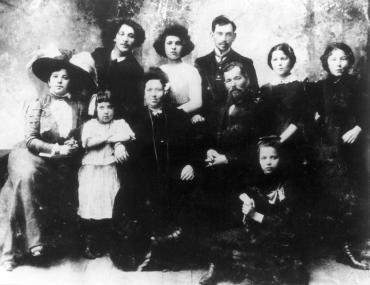
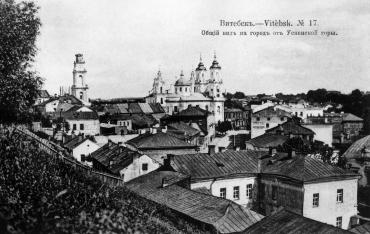
The Second Half of the 1890s
Chagall attended the heder, a traditional Jewish elementary school where around ten local boys aged between three and thirteen were instructed by a tutor. He looked after them and taught them prayers and Bible passages in Hebrew. Chagall also took singing and violin lessons there. He would spend his summers in Liozno, a village around 40 kilometers from Vitebsk, where he’d be surrounded by his grandparents, uncles, aunts, and various farm animals.
1900-1905
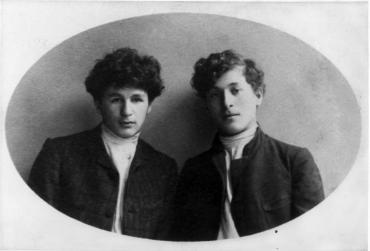
At age thirteen, Chagall began receiving a secular Russian education at Vitebsk’s official middle school, which was challenging, given his Jewish roots. He was one of a handful of Jewish students at the school, along with sculptor-to-be Ossip Zadkine and Viktor (Avigdor) Mekler, who became Chagall’s friends. Chagall, a shy dreamer who lacked drive, dropped out of school in 1905 without a diploma.
1906
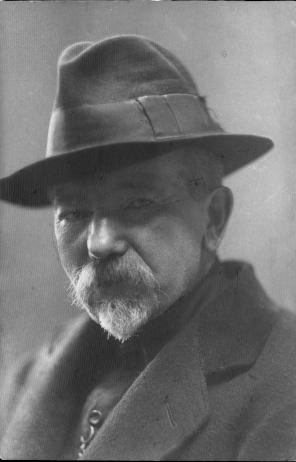
Chagall received his first artistic training at the only art school in this provincial town, which was opened by Iouri (Yehuda) Pen, an academic painter inspired by the Peredvizhniki movement. At the behest of his mother, Chagall also took on an apprenticeship retouching negatives for Abel Miestchaninov, the brother of sculptor Oscar Miestchaninov.
1907
During the winter of 1906-1907, Chagall left for Saint-Petersburg with his friend Mekler. Broke and lacking an official residency permit, the artist went through trying times in his early days in the capital. He earned a living drawing shop signs. Having failed to be accepted at the Stieglitz arts and crafts school, Chagall enrolled at an art school founded by the Imperial Society for the Preservation of Fine Arts. Its director was the painter, archeologist, and philosopher Nicholas Roerich, who was closely involved with the Mir Iskusstva (World of Art) magazine. Starting in April 1907, he received a scholarship of six roubles, and between September 1, 1907 and September 1, 1908 he received fifteen roubles.
1908
Baron David Ginzburg introduced Chagall to Jewish intellectuals from St. Petersburg, such as lawyer Grigoriy Goldberg—who employed him as a servant to secure his residency permit—and lawyer Maxim Vinaver, a deputy in the Duma. Vinaver introduced Chagall to celebrated literary figures such as his brother-in-law Leopold Sew, Maximilian Syrkine, and S. Pozner. When drafted for military service, Chagall managed to postpone his conscription thanks to support letters from his guardians, Roerich and Ginzburg.
During the summer, Chagall stopped attending Roerich’s lessons and left for Vitebsk where he painted View from a Window. Vitebsk and Portrait of Sister Maryasinka. Chagall probably started his first masterpiece, The Death, in Vitebsk.
1909
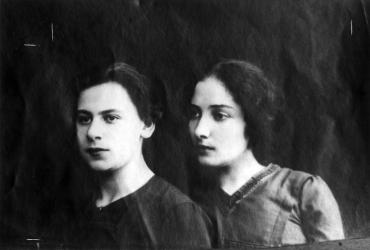
Chagall spent the summer in Vitebsk and Liozno, where at the end of the summer he met the love of his life, Bella Rosenfield. She was the youngest child from a wealthy Jewish family of jewelers.
In September, on Sev’s recommendation, Chagall entered the prestigious Zvantseva art school. The painter Leon Bakst was one of the faculty members. Bakst was famous in Paris for his stage sets and costumes, which he designed for Serge de Diaghilev’s Ballets Russes.
1910
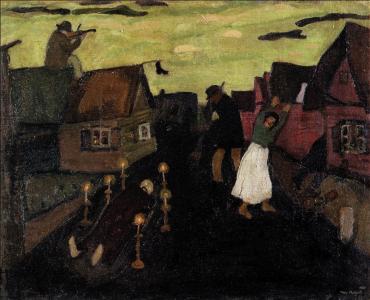
According to one source, Chagall offered Bakst his services as a decorator for the Ballets Russes, and even helped create the costumes and stage curtains for Narcisse. However, Bakst apparently put an end to this collaboration.
Chagall displayed two paintings at the Zvantseva School exhibition, held at the offices of Apollon magazine: The Death and Peasant Eating.
1911
In the winter, Chagall returned to St. Petersburg and moved in with Goldberg. Vinaver purchased two paintings from him, including The Wedding, and gave him a scholarship of 125 francs to pay for his studies abroad. In April, Chagall displayed his work at an exhibit held by the Union of the Youth (Soyuz Molodyozhi), a society of painters made up of Russian futurists, not long after the society was founded in late 1909.
In early May, the artist left for Paris, via Berlin. “I discovered light, color, liberty, sunshine and a joy for life there,” (Roditi, 2006, pp. 9-10), he said when describing his first impressions of Paris.
In the French capital, he encountered his childhood friend Mekler who had come to France a year earlier, and became friends with Yakov Tugendhold, the art critic who later wrote the first Chagall monograph, published in 1918. Chagall spent the first few days living with Mekler before moving to 18, impasse du Maine. He attended the Palette and Grande Chaumière Academies, and visited galleries, exhibits, and museums including the Louvre.
Chagall painted I and the Village, To Russia, Asses and Others, and To My Fiancée, which he attempted, unsuccessfully, to show at the Autumn Exhibit.
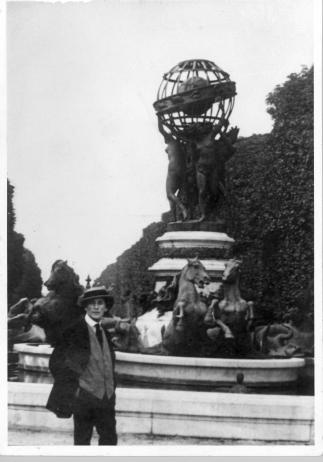
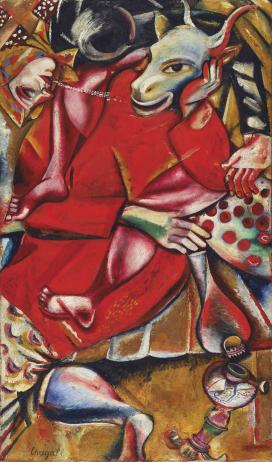
1912
In the winter, Chagall moved into a workshop in La Ruche, an artist residency home to Fernand Léger, Amedeo Modigliani, Alexander Archipenko, Chaïm Soutine, Ossip Zadkine, and David Shterenberg. He made friends with the poets Blaise Cendrars, Max Jacob, André Salmon, and Guillaume Apollinaire.
Chagall’s work was shown at the Salon des Indépendants (To Russia, Asses and Others, To My Fiancee, and The Drunkard), as were three paintings at the Autumn Exhibit. These included Golgotha.
1913
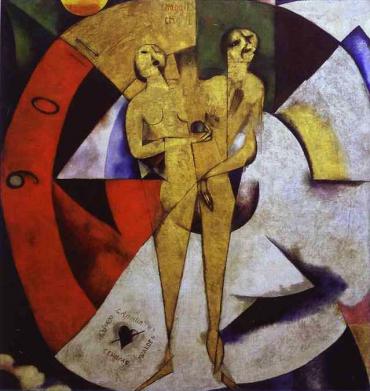
Between March and May, Chagall’s work was shown once more at the Salon des Indépendants with two new canvases, The Birth and Adam and Eve, as well as some drawings.
Chagall got to know Herwarth Walden, the famous collector and dealer from Berlin, after Apollinaire introduced the two men. Walden, who was editor of Der Sturm magazine and owned the gallery of the same name, invited Chagall to take part in the first German Autumn Exhibition. The artist sent three paintings: To Russia, Asses and Others, To My Fiancée, and Golgotha.
1914
In the spring, three of Chagall’s paintings were on display at the Salon des Indépendants: The Violinist, Maternity, and Self-Portrait with Seven Fingers.
The artist’s first major show was held in June and July at the Der Sturm gallery in Berlin, where Chagall exhibited forty paintings and 160 gouaches, watercolors, and drawings from his Parisian period. On June 15, after the opening, Chagall left Berlin and stayed briefly in Vitebsk, but was forced to stay in Russia after the war broke out. He moved in with his parents and began his Vitebsk series (The Newspaper Seller, Over Vitebsk, Jew in Green, Celebration Day) and created a series of war drawings.
1915
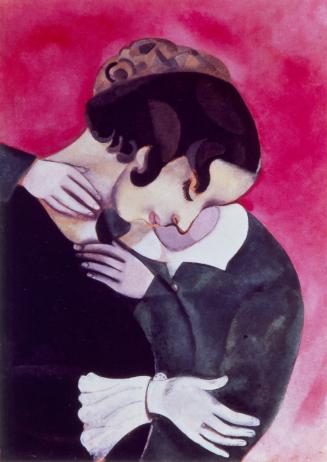
Twenty-five paintings in the Vitebsk series were displayed L’Année 1915, an exhibit at Moscow’s Mikhailova art salon. Two renowned collectors, Ivan Morozov and Jacob Kagan-Chabchaï, bought his works.
Chagall married Bella Rosenfeld on 25 July. Following a stay at Zaolché (cf. The Poet Reclining, Window at the Dacha) and Vitebsk, where Chagall painted Birthday and some works in the Lovers series, the couple settled in St. Petersburg, known as Petrograd between 1914 and 1924. In order to complete his military service, Chagall worked for Bella’s brother, Jacob Rosenfeld, who was serving as head of the military-industrial complex. He met great poets such as Alexander Blok, Sergei Yesenin, Vladimir Mayakovsky, and Boris Pasternak.
1916
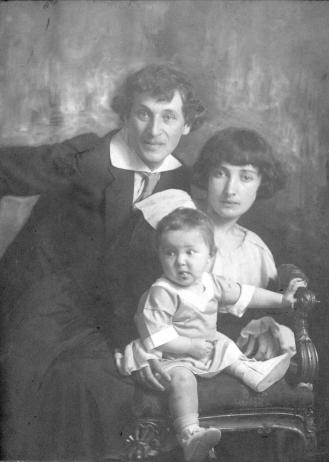
His daughter Ida was born on 18 May.
Chagall showed his work several times at Nadejda Dobytchina’s gallery. Dobytchina was both a friend and a keen sponsor, who endeavored to amass a large collection of Chagall’s work. In November, he exhibited forty-five pieces at the Valet de Carreau, including the Vitebsk series, The Birthday, The Acrobat, The Mirror, and Blue Lovers.
1917
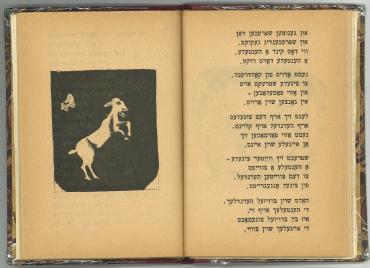
After 1917’s February Revolution, the provisional government adopted a law abolishing any national or religious discrimination. Chagall was finally able to fully enjoy Russian citizenship as a Jew.
From March, Chagall was drawn to what were known as “leftist” artistic trends, and became a member and delegate of the Union of the Youth.
In March and April, Chagall participated in the second exhibit held by the Jewish Society for the Encouragement of the Arts at Moscow’s Lemercier Gallery, as an artist and jury member. Chagall’s work was featured in one of the central areas, where he exhibited fifteen paintings and around forty drawings.
He spent his summer in Vitebsk and Zaolché, where he painted Bella with White Collar, Jewish Cemetery, and Cemetery Gates.
In Vilnius, the Kletzkine publishing house released two Yiddish books with illustrations by Chagall, Stories by Der Nister and The Magician by Peretz.
1918
The artist painted some important works during his time in Vitebsk: Over the City, The Promenade, The Wedding, Double Portrait with a Glass of Wine, and The Apparition.
In August, Chagall was appointed as fine arts commissioner of the Vitebsk region. Charged with organizing the October Revolution’s first anniversary celebration, he designed the decorations, among other things, before dedicating himself to creating a People's Art School and a museum.
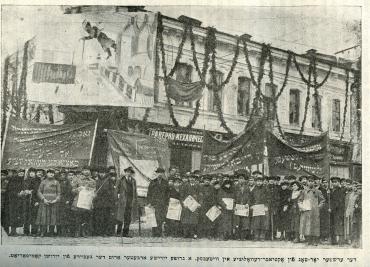
1919
January saw the official inauguration of the school, where 120 students from various social classes were enrolled. Chagall was appointed chairman and ran one of the painting workshops, while Mstislav Doboujinski was the director until he left Vitebsk in April. Chagall named teachers and artists from a variety of artistic currents, such as Alexander Romm, Vera Ermolaeva, Yuri Pen, and Lazar Lissitzky. Most notably, he invited Kazimir Malevich, the inventor of Suprematism, who arrived in November.
At the first official Exhibit of Revolutionary Art at the Palais des Arts (April13–June 29, the former Palais d’hiver), Chagall exhibited twenty-four works, of which twelve were purchased by the State.
In June and July, an initial exhibit was held, which brought together works by students from the Vitebsk school and local painters.
The “Première exposition d’État d’œuvres d’artistes locaux et moscovites” (First State exhibition of local and Muscovite artists) was held in November and December. It displayed 241 works by forty-one artists including pioneers of the avant-garde movement such as Altman, Bourliouk, Exter, Falk, Kandinsky, Konchalovsky, Lentulov, Lissitzky, Malevich, and Rodchenko.
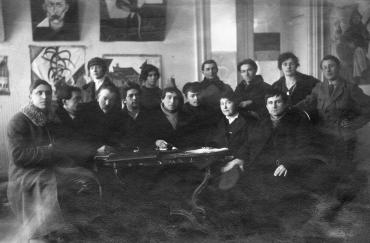
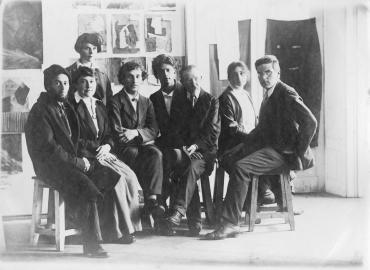
1920-1921
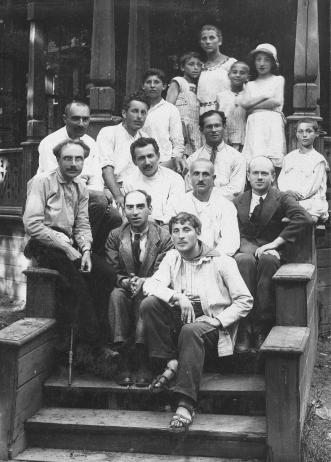
Chagall worked on creating the Vitebsk Museum of Modern Art, a collection of some hundred pieces, which opened in July–August 1920. According to Romm, “The collection represents all the currents of contemporary painting, from academicism and Impressionism to Suprematism[1].”
After falling out with Malevich, Chagall left for Moscow at the beginning of June. The Narkompros (People's Commissariat for Education) repeatedly rejected his resignation request, then finally confirmed it officially on June 19.
In November 1920, Chagall was invited to work at the Jewish Kamerny Theater. The Theater had just relocated from Petrograd, and the artist created sets and costumes for its first Moscow show, An Evening of Sholem Aleichem, made up of three short plays: Agents, It's a Lie, and Mazl Tov, starring the actors S. Mikhoels and V. Zuskin. Chagall also painted murals for a Kamerny Theater venue which was then renamed “Chagall's Little Box.”
For most of 1921, Chagall taught a settlement of Jewish war orphans in Moscow’s Malakhovka suburb.
[1] A. Romm, “O mouzeïnom stroïtelstve i Vitebskom mouzéié sovremennogo iskousstva” [On museum building and Vitebsk Museum of Modern Art], Iskusstvo [Art], n° 2-3, April-May 1921, pp. 6-7.
1922-1923
In early 1922, Chagall left Malakhovka and prepared to go abroad. He left Russia definitively in April and returned to Berlin, via Lithuania (Kaunas).
In Berlin, Chagall was shocked to discover that Herwarth Walden had sold all the works he had left there. On June 12, 1923, criminal proceedings were brought against the German dealer for fraud. The proceedings were partially settled after three of the works were returned: I and the Village, The Drover, The Cattle Dealer, and To Russia, Asses, and Others.
Chagall finished writing My Life before returning to Paris.
In January 1923, Berlin’s Galerie van Diemen exhibited 164 works by the artist, which he’d completed between 1914 and 1922.
1923-1925
Chagall’s family arrived in Paris on September 1st and spent the first few months in a room at the medical hotel on Faubourg Saint-Jacques. In early 1924, the family moved into 10, avenue d’Orléans where they stayed until late 1925, when they moved to Boulogne-sur-Seine.
After suggesting that he illustrate a book written by the Countess of Ségur, Ambroise Vollard accepted the painter’s proposal to illustrate Gogol’s Dead Souls, for which he produced 107 etchings between 1923 and 1925.
Frequent stays in Normandy, Brittany, and Oise followed. There, Chagall became acquainted with France’s landscapes and pictorial tradition, and he produced a number of floral compositions.
His work was displayed in galleries in Paris, Brussels, Cologne, and Dresden.
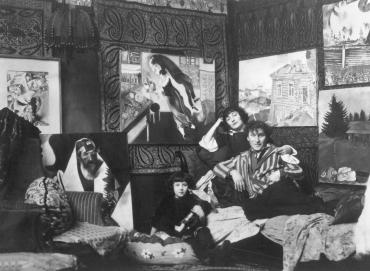
1926-1927
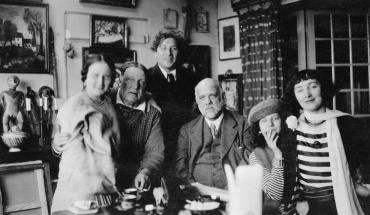
Chagall exhibited for Katia Granoff in Paris, then displayed around a hundred pieces at his first New York exhibit in early 1926, organized by Reinhardt Galleries.
He stayed at Chambon-sur-Lac in Auvergne for a few months, where he painted, on commission from Ambroise Vollard, around thirty gouaches in preparation for etchings for La Fontaine’s Fables. Towards the end of 1927, Chagall produced a series of gouaches entitled Vollard Circus.
The artist produced fifteen etched illustrations for Marcel Arland’s Maternity, and for The Seven Deadly Sins by Jean Giraudoux, Paul Morand, Pierre Mac Orlan, André Salmon, Max Jacob, Jacques de Lacretelle, and Joseph Kessel. He also produced ninety-two drawings to illustrate Gustave Coquiot’s Suite Provinciale. Coquiot introduced him to Rouault, Bonnard, Vlaminck, and Maillol. The painter connected with Zervos, through whom he met Picasso, as well as Tériade, Pablo Gargallo, and Pierre Chareau.
In late 1926, Chagall signed a contract with the Bernheim-Jeune gallery in Paris, which represented Cézanne, Renoir, Monet, and Matisse.
During that time, the Chagall family left to explore central and southern France. In November 1927, the artist spent six days traveling with Robert Delaunay in his new Overland. The two artists visited Jean Girou and Joseph Delteil, and dropped in to see Maillol at Banyuls-sur-Mer.
Late that year, the painter discovered Savoie, Chamonix, Les Houches, and Les Bossons, which inspired some deeply peaceful snowy landscapes reminiscent of his Russian homeland.
1928-1929
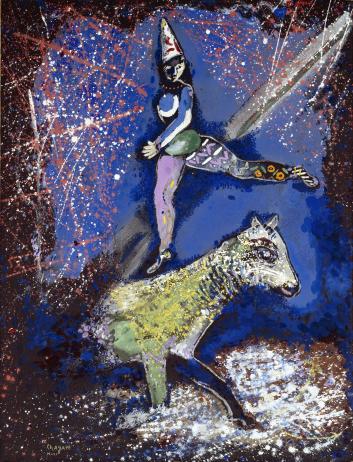
Chagall continued to work on the Vollard Circus series and his black-and white-etchings for Fables.
In summer 1928, Chagall went to Céret, in the Pyrenees, returning with Bella in autumn 1929. In late 1929, the artist purchased Villa Montmorency, a gated residence in Paris’s 16th district.
Chagall and his wife met philosophers Jacques and Raissa Maritain, whose Franco-Jewish-Russian origins mirrored his own. They became regular guests on Sunday events in Meudon, held by the couple, with Jean Cocteau, Georges Rouault, and Max Jacob among the notable attendees.
1930-1931
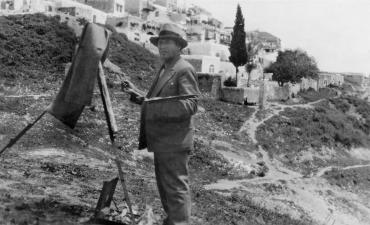
In February 1930, the preparatory gouaches for Fables were displayed at the Bernheim-Jeune gallery in Paris, Le Centaure gallery in Brussels and lastly at the Flechtheim Gallery in Berlin, where Chagall attended the official opening. They all sold.
On invitation from Meir Dizengoff, the mayor and founder of Tel Aviv, Chagall visited Palestine with Bella and Ida between February and April 1931. Chagall, who was distraught by the Palestinian sites he saw, worked in Tel Aviv, painting synagogue interiors in Safed and landscapes in Jerusalem. He returned to Paris, richer for the experience, and immediately set to work on the preparatory gouaches and Bible etchings commissioned by Vollard the previous year.
In 1931, the Stock publishing house in Paris released the French translation of My Life.
1932-1933
Chagall continued to work tirelessly on his Bible illustrations.
Hitler had come into power in Germany, and the Nazis made Chagall’s The Praying Jew, which was displayed in a Mannheim museum, one of the first examples of Jewish degenerate art.
The artist’s request for French citizenship was rejected because of the role he had occupied as fine arts commissioner in Vitebsk.
In late 1933, a large retrospective of 170 works was hosted at the Kunsthalle in Basel, a city located on the border between Switzerland, Germany, and France.
1934-1938
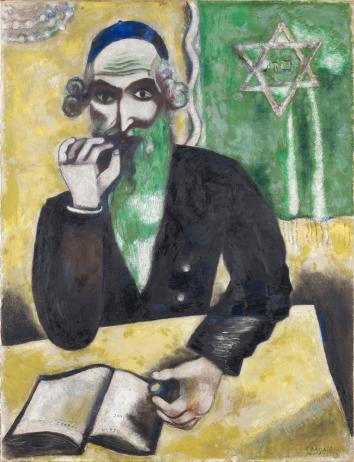
Chagall and Bella spent the summer of 1934 traveling around Spain. The painter also visited Tossa de Mar with Supervielle and Michaux.
In late 1936, Chagall moved into a new workshop at 4, Villa Eugène-Manuel, near the Trocadéro in Paris.
With the help of his French friends, in particular Jean Paulhan, Chagall obtained French citizenship. His naturalization decree was published in the Official Journal on June 13, 1937.
In 1937, with the mood becoming increasingly tense due to growing antisemitism, the painter revisited the theme of revolution. Under the Nazi regime, all of the artist’s work was taken down from German museums, and three of his works were classified as degenerate art: Purim, The Pinch of Snuff (Rabbi), and Winter.
1939-1940
Believing, wrongfully, that he was under threat, Chagall moved to Saint-Dyé-sur-Loire shortly before the war broke out. There, with the help of his daughter Ida, he transported all the canvases from his Paris workshop by taxi. Germany’s invasion of France in May 1940 forced the family to take refuge in Gordes, south of the Loire, where Chagall purchased a former Catholic girls’ school. He transported his works from Saint-Dyé and turned the biggest room into a studio.
1941
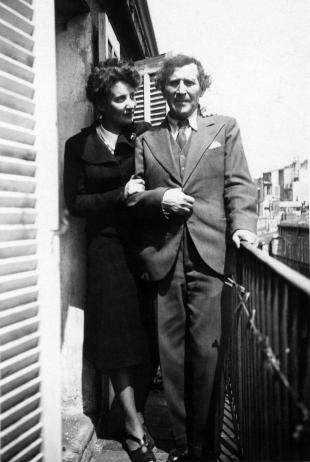
During the course of the winter, Emergency Rescue Committee director Varian Fry, and the United States consul general of Marseille, Harry Bingham, invited the artist to the MoMA in New York along with Matisse, Picasso, Rouault, Masson, and Max Ernst.
After being arrested at the Hotel Moderne in Marseille, and being released thanks to interventions from Varian Fry and Bingham, Chagall decided to leave France temporarily. The artist and his wife traveled through Spain and Portugal before arriving in New York on June 21. Six hundred kilograms of boxed-up works were delayed for five weeks in Madrid before finally being loaded onto Ida Chagall’s boat, following her intervention. As soon as he arrived in New York, Pierre Matisse became Chagall’s personal representative. Matisse continued to show Chagall’s works until the end of his life.
1942
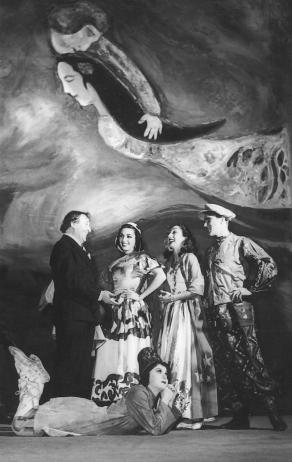
Chagall created the sets and costumes for the ballet Aleko, which was choreographed by Léonide Massine for the New York Ballet Theater. However, the scenography was completed in Mexico. The premiere was held at the Palacio de Bellas Artes, Mexico City’s majestic Art Deco building, on September 8. The influence and intense colors of Latin American culture and can be seen in the way the projects transferred from New York were altered. Just like the ballet’s premiere in South America, the New York show—performed for the opening of the Metropolitan Opera House—was a resounding success.
1943
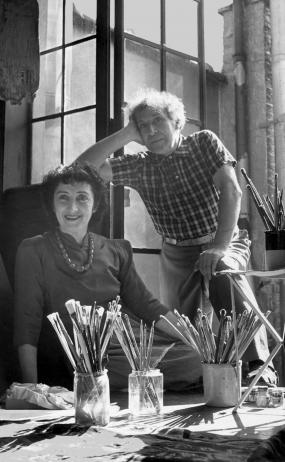
The heartbreaking stories coming out of war-torn Russia were troubling to Chagall, whose ties with his homeland were strengthened when his old friends Solomon Mikhoels and poet Itzik Fefer visited him in New York. During their three-month stay, the artist saw them almost every day. The Chagalls spent several months at Cranberry Lake, whose forests, birch trees, and snow reminded them of their native Russia.
On May 5, 1943, Marc Chagall was stripped of his French nationality by the Vichy regime, under the law of July 22, 1940, which called all naturalizations into review.
1944
The Chagalls were at Cranberry Lake when they heard about the Normandy landing on the radio. They were hugely excited to learn of the liberation of Paris.
Bella contracted a viral infection and developed a high fever. She was hospitalized but died thirty-six hours later, on September 2. She’d been unable to access emergency treatment which at that time was only available primarily to the American army. “Everything went dark,” Chagall wrote in the afterword for Burning Lights. For nine months, Chagall was unable to take up his paintbrush and his paintings remained facing the wall.
1945
Chagall and his daughter Ida began translating and illustrating the first volume of Bella’s memories, Burning Lights, which she’d written in Yiddish.
That summer, Ida appointed a young French-speaking English woman, Virginia McNeil, to look after her father.
Chagall, who had managed to regain his creative momentum following Bella’s death, worked fervently on the sets for Stravinsky’s The Firebird.
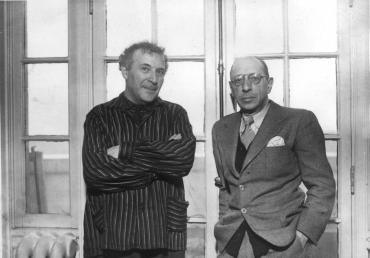
1946
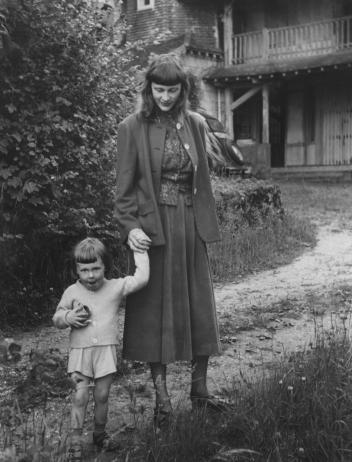
In March, Chagall purchased a modest home in High Falls, in northwestern New York State. He moved in with Virginia, with whom he would share his life for seven years, and who gave birth to their son David on June 22. In this new house, Chagall, upon commission by publisher Kurt Wolff, devoted himself to creating wonderful gouaches in preparation for the first color lithographs for One Thousand and One Nights.
Ida set to work preparing two large retrospectives on her father’s work, the first since the 1933 Basel retrospective. One of them was organized by James Johnson Sweeney at the New York’s Museum of Modern Art, and was unveiled in 1946. The second was designed by Jean Cassou, director of the Paris Museum of Modern Art, as part of an major tribute to Chagall planned for the museum’s reopening in 1947. As his daughter had, Chagall went to Paris for a short three-month stay, and reestablished contact with Europe and France, where he hoped to return. He illustrated a collection of poems by Paul Éluard, The Hard Desire to Endure.
1947
Chagall attended the opening of the retrospective held by Paris’s Museum of Modern Art. Other retrospectives were held at the Stedelijk Museum in Amsterdam, the Tate Gallery in London, the Kunsthaus in Zürich, and the Kunsthalle in Bern.
1948
In August, Chagall, Virginia, and the children boarded the De Grasse ocean liner and debarked a few days later at the harbor of Le Havre. The couple moved to Orgeval and welcomed old and new friends, including Louis Carré, and also Aimé Maeght who became Chagall’s representative in France. They also saw the publishers Zervos and Tériade, who went on to acquire all the etchings and copper engravings for Dead Souls, Fables, and the Bible from Vollard’s collection. In September, Chagall went to the Venice Biennale where he received the prize for engraving.
1949
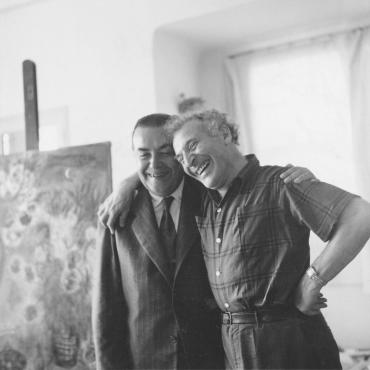
From the start of the year, Chagall spent four months at Tériade’s home in Saint-Jean-Cap-Ferrat. The publisher had commissioned him to produce washes and drawings using Chinese ink, based on Boccaccio’s Decameron, for the 1950 issue of his art and literature magazine Verve.
1950-1951
Chagall, captivated by Vence’s natural landscapes, purchased Les Collines, a villa with a magnificent garden filled with flowers and fruit trees. He lived there for sixteen years.
Buoyed by the Mediterranean light and a new environment that facilitated the creative process, the artist created his first ceramics. He also finished a number of incomplete pieces and designed paintings and works on paper that celebrated lovers, nature, and sacred Bible texts, themes that he continued to explore throughout the following years.
Virginia left Chagall for the photographer Charlies Leirens, taking along her two children to Brussels.
1952-1953
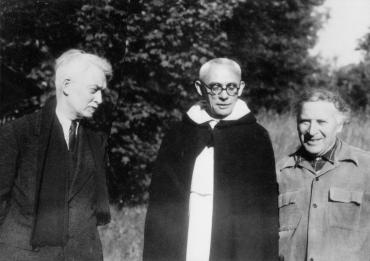
The painter came to know the Russian-born Valentina (Vava) Brodsky, whom he married on July 12, 1952. Chagall created ceramic murals, vases, and pitchers at Suzanne and Georges Ramié’s Madoura workshop in Vallauris, where he worked until 1962.
At the request of Father Marie-Alain Couturier, Chagall began devising a project to decorate the Notre-Dame-de-Toute-Grâce, on the plateau d'Assy, which he would not complete until 1957, after the priest’s death.
1954-1955
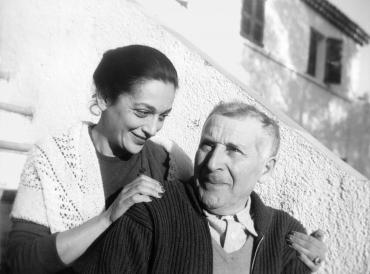
In autumn, Chagall and Vava traveled in Greece and Italy as if on a honeymoon. The new experiences from this trip undoubtedly inspired the vibrant solar colors and pastoral shapes seen in the Daphnis and Chloé cycle that he was creating at the time.
1956
Chagall fully devoted himself to producing lithographs and etchings. Tériade published The Bible. Exhibits were held in Basel, Bern, and Brussels in tribute to the artist.
Shortly after creating sketches in preparation for the Grand Circus of 1956, the painter began working again on his monumental paintings for the Biblical Message series, which he finished in 1966.
1957
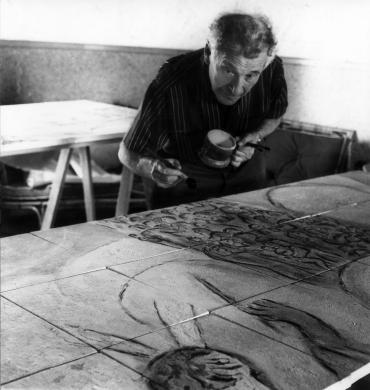
Chagall completed a painting on cardboard in preparation for his first mosaic mural, The Blue Rooster, which was completed by mosaicists in Ravenna the following year.
The ceramic mural Crossing of the Red Sea was hung in the baptistery of the plateau d’Assy church.
1958-1959
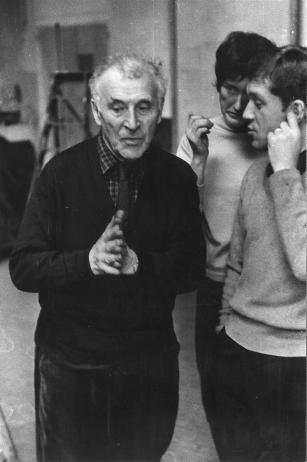
The Paris Opera commissioned theater sets and costumes for Daphnis et Chloé, the ballet by Maurice Ravel and Michel Fokine, choreographed by George Skibine.
Chagall got to know the master glassmakers Charles Marq and Brigitte Simon, who were also directors of the Simon workshop in Reims. They worked together to address problems arising from the artist’s use of rich colors and on the transposition of stained-glass window mock-ups for Metz cathedral, which were created in 1959.
1960
Early in the year, Chagall painted gouaches in the snowy Swiss village of Sils Maria.
In October, the artist won the Erasmus Prize along with Oskar Kokoschka.
1961-1962
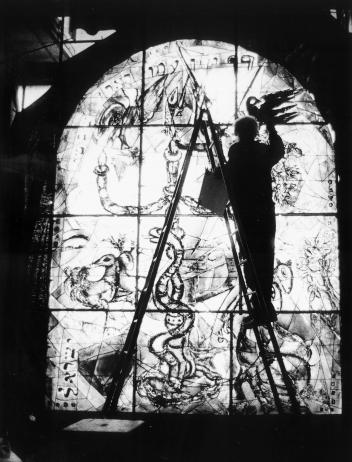
Tériade published Daphnis and Chloé.
The twelve stained-glass windows prepared for the synagogue at Jerusalem’s Hadassah Medical Center were displayed at the Museum of Decorative Arts in Paris, and later at the Museum of Modern Art in New York.
On February 6, 1962, Chagall attended the official unveiling of the stained-glass windows in Israel.
1963-1965
The artist’s first Japanese retrospective was held in Tokyo and Kyoto.
Chagall worked on the models for three huge tapestries destined for the Knesset, the new Parliament, which he planned to donate to the State of Israel.
Chagall and his wife went to New York for the opening of the Peace Window at the United Nations headquarters.
André Malraux invited the artist to design a new ceiling for the Garnier opera house. Chagall subsequently decided he would pay homage to fourteen composers, including Debussy, Ravel, Mussorgsky, Tchaikovsky, and Mozart.
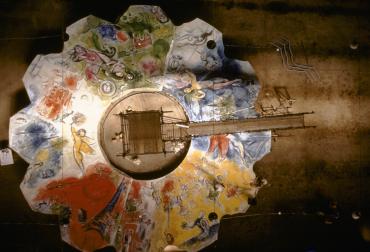
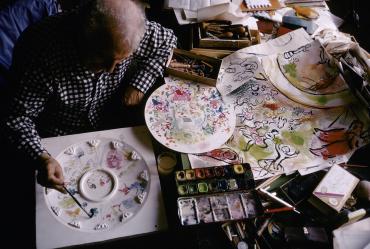
1966-1967
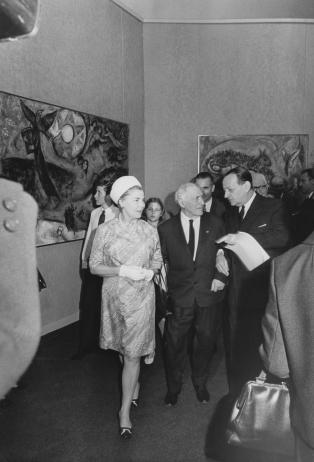
In 1966, Chagall and Vava left Vence and settled in La Colline, a house they’d had built at Saint-Paul-de-Vence. The architecture was designed to facilitate work with various artistic techniques.
In February 1967, the premiere of The Magic Flute at New York’s Metropolitan Opera, with sets and costumes designed and painted by Chagall, was a great success. Incidentally, Chagall had also painted two murals, The Sources of Music and The Triumph of Music, for this establishment.
From June to October 1967, the Louvre Museum exhibited the Biblical Message works. Marc and Valentina Chagall gifted the pieces to the French State, on the condition that a museum be built in Nice to house the seventeen large paintings and thirty-eight gouaches.
1968-1970
Chagall painted the mock-up for The Message Of Ulysses, the immense mosaic created by Lino Melano, on commission from the University of Nice law faculty.
In 1968, the artist created stained-glass windows for Metz cathedral’s north transept.
Chagall went to Israel for the inauguration of the Knesset in Jerusalem, for which the artist had completed a mosaic mural called The Wailing Wall, and three large tapestries – The Prophecy of Isaiah, Exodus, and Entry to Jerusalem – which were woven at the Gobelins Manufactory in Paris.
The large retrospective Homage to Chagall, combining 414 works, opened at the Grand Palais in Paris.
In September 1970, five stained-glass windows were unveiled at the Fraumünster Church in Zurich.
1971-1973
The artist designed the model for Elijah’s Chariot, a mosaic intended to adorn the facade of the Marc Chagall National Biblical Message Museum in Nice, alongside models for the Four Seasons mosaic commissioned by the First National City Bank in Chicago.
In 1973, on invitation from the Soviet Union Culture Minister, Chagall went with his wife to Moscow for the first time since 1922. On this occasion, he signed panels at the Jewish Art Theatre and met up with two of his sisters, Lisa and Mariaska,
On 7 July 1973, the Marc Chagall National Biblical Message Museum opened in the presence of André Malraux.
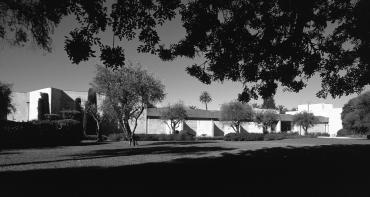
1974-1977
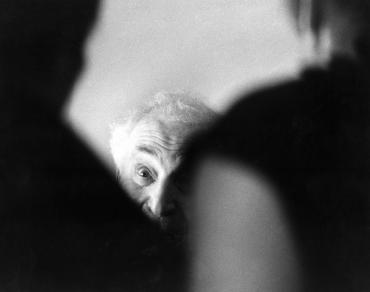
In June 1974, three stained-glass windows – Abraham and Christ, The Tree of Jesse, and French Kings – were unveiled at Reims Notre-Dame cathedral.
Chagall travelled to Chicago for the installation of the Four Seasons mosaic on the First National Plaza, which was warmly received by the public.
1978-1980
In 1978, he finished the stained-glass windows designed for the Chapel of the Cordeliers in Sarrebourg.
On January 1, 1978, the artist was awarded the Grand Cross of the Légion d'honneur by the President of the French Republic. The same year, he was appointed as an honorary citizen of the city of Jerusalem.
Again that year, the first of nine stained-glass windows was unveiled at the Saint-Étienne church in Mainz, as was as a stained-glass window at Chichester Cathedral.
In 1979, for the United States Bicentennial, three stained-glass windows dedicated to the Arts were unveiled at the Art Institute of Chicago.
1980-1983
A collection of stained-glass windows devoted to the Tree of Life were unveiled at Saint-Étienne church in Mainz.
Six stained-glass windows destined for the Saillant parish church in Voutezac were completed.
In 1982, two retrospective exhibits were held at the Moderna Museet and Stockholm and the Louisiana Museum in Humlebæk, near Copenhagen.
1984
The artist’s works on paper were honored at the National Museum of Modern Art in Paris before being exhibited in Hanover, Zurich, and Rome.
The Maeght Foundation in Saint-Paul-de-Vence held a retrospective of the artist’s paintings, while the Marc Chagall National Biblical Message Museum (now the Marc Chagall National Museum) opened an exhibit devoted to his stained-glass windows and sculptures.
1985
London’s Royal Academy of Arts devised a vast retrospective, which was then taken on by the Philadelphia Museum of Arts.
The evening of March 28, after spending the day in his studio, Marc Chagall passed away. His funeral was held on April 1st at the Saint-Paul cemetery, where the artist now rests.